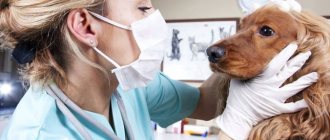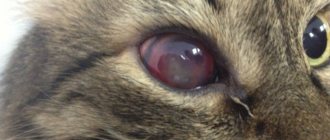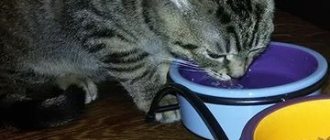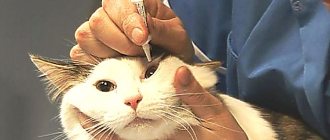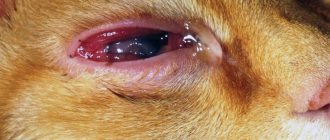8340Pavel
1
Unfortunately, cat breeders, even the most experienced of them, periodically face the negative consequences of communicating with their pets. Let's consider the question of what to do if a cat scratches its eye. In case of unforeseen consequences of the behavior of a domestic predator, it is very important to know the sequence of correct actions in a given situation. The principle of action is almost the same regardless of who is injured - an adult, a child or a recently acquired puppy.
We will not delve too deeply into the reasons for this behavior of a pet or pet. Perhaps the animal was just acting out, perhaps the question is that the aggression was shown by a cat - a mother instinctively protecting her kittens, or a sick animal, which now, perhaps even accidentally, was hurt during medical procedures.
© shutterstock
Symptoms of eye injury
Penetrating injury causes redness of the conjunctiva, spasm and swelling of the eyelids. If the eyelids are also damaged, there may be capillary bleeding. There is also profuse lacrimation, clouding and visible violations of the integrity of the cornea with the leakage of intraocular fluid outward. If the iris is injured, hemorrhage will occur in the anterior chamber of the eye, and if the lens is injured, it will become cloudy and a severe inflammatory process will occur inside the eye.
All the symptoms described above can lead to loss of vision, and without emergency help and the prescription of drugs that control inflammation and accelerate the recovery of the cornea, to the loss of the eye as an organ as a whole.
Symptoms of a scratched cornea
If an animal accidentally or intentionally scratches your or your child's eye, the following symptoms will be present::
- Palpable pain that increases when opening or closing the eyelid
- Blurred vision
- Tearing
- Reddened cornea
- Photosensitivity
In some cases, a headache may occur after a cat scratches an eye.
© shutterstock
First aid “here and now” before visiting an ophthalmologist
If there is contamination of the wound (sand, wool, etc.) and bleeding, you can wash the eye with a sterile warm (room temperature or body temperature 36-37 degrees) solution of Sodium chloride 0.9% (saline). It is drawn into a syringe, the needle is removed or broken off, then the cornea and eyelids are poured. In addition to saline solution, you can use any veterinary eye lotion. If the wound is relatively clean, it is better not to rinse the cornea again, as this is very painful for the pet.
If you have antibacterial eye drops on hand, you should start using them as soon as possible (suitable options are Tobrex, Floxal, Tsipromed, Ciprofloxacin, Levomycetin, Iris, Tsiprovet).
It is not recommended to use drops with sodium sulfacyl, as their use causes severe pain, which can lead to worsening of the eye condition.
Getting particles, dust, sand and other small particles from the environment into the eye
Before visiting a veterinarian, it is recommended to rinse the injured eye with saline solution of sodium chloride or warm boiled water. In a veterinary clinic, the doctor treats the affected eye and applies a solution of novocaine (2%) to reduce pain. Then manipulations are carried out to remove the speck from the eye.
To do this, take a swab moistened with a special solution. The veterinarian spreads the eyelids and pours the solution out of the swab into the place where the speck is approximately located. If it is clearly visible, then you can remove the particle with the corner of a cotton swab. After its removal, anti-inflammatory or antimicrobial eye drops are instilled to prevent infection of the damaged organ of vision.
What will the doctor do at the appointment?
A complete ophthalmological examination will be performed, which includes:
- biomicroscopy of the eye (examination under magnification);
- ophthalmoscopy (examination of the retina and optic nerve head for post-traumatic damage);
- assessment of pupil reactions to light;
- An ultrasound of the eyeball is done when there is severe swelling of the cornea and it is impossible to examine the internal structures of the eye;
- fluorescein test (staining the cornea with a safe dye) - if necessary.
The test allows you to evaluate several positions at once: the area and depth of damage, the retention time of the tear film. Thanks to this, one can judge the presence or absence of dry eye syndrome and the patency of the nasolacrimal duct.
When to seek veterinary help?
An eye injury in a dog is a serious problem that requires immediate attention to a veterinarian. There are various problematic situations in which it is necessary to rush to the veterinarian.
- Getting injured as a result of an unpleasant interaction with a street cat. A fight between an angry cat and a dog can be costly for the animal's health. If in the first hours after the injury your pet rubs its eye vigorously, squints and rushes from side to side in pain, it is necessary to carefully examine it. If, after an injury, clouding of the cornea in the area of injury, changes in the eyeball, or the appearance of blood or pus are clearly visible, you should immediately go to a veterinary clinic, where a specialist will prescribe the appropriate treatment.
- Mechanical damage due to debris, dust, or sand getting into the eye. When a small foreign body penetrates under the third eyelid, severe irritation appears on the cornea of the eye. The dog will try to scratch his eye with his paw and squint all the time. He will experience discomfort and pain. If excessive tearing occurs, the dog owner needs to be wary. In this case, it is necessary to remove a speck of dust or speck from the eye in a veterinary clinic. Otherwise, complications may occur, including blindness.
- Traumatic injury due to penetration of the eye by a sharp object. When a branch, stick or other object gets into the eye, the cornea is damaged and a wound is formed into which various microbes and bacteria penetrate. If the dog has an urgent need to squint, this may also indicate a minor injury. With a strong blow, an injured animal may completely close its eyes and experience pronounced painful sensations. If at the same time purulent or bloody discharge appears in the corners of the eyes, the dog does not allow the eyelid to open and behaves aggressively, you should immediately take him to the veterinary clinic. Timely treatment will save the animal's eye.
Treatment of penetrating eye injuries in cats and dogs
After assessing the condition of the eye and the patient as a whole, the ophthalmologist selects an individual treatment plan. If necessary, surgical treatment of the wound with suturing of the edges is performed. Eye drops and moisturizing ophthalmic gels are also prescribed, which will help avoid eye infection and speed up the recovery of the cornea.
If the damage is more serious and deep, affecting the iris and lens, systemic anti-inflammatory and antibacterial therapy is also prescribed. These are tablets or suspensions that are taken orally. Unfortunately, in some cases the lens must be removed.
During this period, it is important to use a protective collar, as pets often want to scratch the sore eye with their paw or rub it against surrounding objects.
A street cat scratched a dog's eye during a fight.
What should you do in this case? At home, you can prepare an infusion of chamomile or calendula and gently rinse the injured eye with it. To prevent infection of the second healthy eye, it is recommended to rinse it with a fresh swab dipped in chamomile infusion.
If a dirty cat's claw has slightly scratched your eye, your veterinarian will prescribe an antiseptic wash lotion and eye drops to relieve irritation and inflammation. The course of treatment is individual, as it depends on various factors. The animal is under the supervision of a veterinarian for 1-2 weeks. In case of suppuration, experts recommend treating with antibiotic therapy.
Prevention of corneal injury
If there are several cats in the house or a cat and a dog, it is recommended to trim its nails regularly. How to do this correctly, watch our video. You can also wear special anti-scratch caps. A wide selection of nail clippers and anti-scratch clippers are presented in the Averia Market online store.
But, if an injury does occur, it is necessary to take the animal to an appointment with a veterinary ophthalmologist as soon as possible for examination, assessment of the severity of the injury and the appointment of timely therapy. This increases the chances not only of saving the eye as an organ, but also of preserving vision.
Eye injuries from a claw do not always occur without serious consequences, so try to avoid the possibility of fights involving your pets. This is especially important when traveling with “tails” into nature, where they may not share the territory with local street animals.
What is felinosis and how to prevent it
29.09.2021
What is felinosis?
Felinosis, or cat scratch disease, is an infectious disease transmitted to humans from animals, in this case from infected cats. Cats can carry disease-causing bacteria, but the bacteria does not cause disease in them, or the symptoms of the disease simply cannot be identified. However, these bacteria can be transmitted to a person as a result of a scratch or bite, accompanied by injury to the skin; pathogenic microorganisms enter the lymph through the skin and then spread throughout the body. Bacteria can also enter through the eyes as a result of the saliva of the carrier animal contacting the mucous membrane of the eye .
Felinosis can be a seasonal disease, the peak of which occurs in summer and autumn, and the risk of catching this disease is highest in children and young people. On average, the period from the moment the bacteria enters until the first symptoms of the disease appear (or the incubation period) is about one to two weeks, but it can also be as little as three days, or it can last up to four or even up to six weeks. The course of felinosis is clearly distinguished into three periods: the initial period, the period of the height of the disease and the period of recovery (or convalescence).
Symptoms of cat scratch disease
The first symptoms of felinosis appear directly at the site of a scratch or bite: this place becomes swollen and red, then papules appear on the skin, followed by signs of suppuration. A rash may appear around the area of the scratch or bite. At the same time, inflammation of the lymph nodes closest to the site of infection begins. A person experiences fever, weakness, headache, increased sweating , general malaise, and intoxication. liver may also be observed .
After two or three days, ulcers appear in place of the skin papules, which can open, and then crusts appear, which can then dry out and fall off, leaving no marks on the skin. This lasts approximately one to three weeks. Over time, the inflammation goes away, and sclerosing lesions appear in the area damaged by a bite or scratch.
The disease will be much more severe if the immune system , then pathogenic bacteria can penetrate the blood and the vessels throughout the body, affecting the heart , liver and other internal organs, and already there provoking various inflammatory processes.
Treatment and prevention of disease
Felinosis is not considered a serious illness; it can often go away on its own, but you can still give the body the opportunity to quickly overcome the disease or at least alleviate the symptoms by taking medications. How the disease progresses often depends on the immune system and its state. A more severe and more common form of the disease can occur in people with a weakened immune system or in an immunodeficient body. In turn, a milder form in the form of a localized process may occur in those who have everything in order their immunity But it is still important to remember a few important rules that can protect against the disease.-
- Immediately after a scratch or cat bite, you need to wash the damaged area of skin with soap and water, thereby disinfecting it.
- After playing with cats, you should wash your hands regularly, of course, with soap, and this is especially necessary for people with weakened immune systems
- if the immune system , it is recommended to have cats over a year old, the reason is that the blood of kittens under one year old contains a lot of bacteria
- It’s better not to touch homeless and stray cats or try to play with them
- It is not allowed to allow cats to lick fresh wounds and scratches on the skin
- You can resort to trimming your cats claws
- It is necessary, after consulting with a veterinarian, to use anti-flea products
- It is advisable not to let the cat outside the house so that it does not come into contact with microorganisms and fleas, and thereby you can significantly reduce the risk of infection with them
And it is important to know that when infected with felinosis, self-medication is dangerous, and it is better to seek the help of doctors
Published in Infectology Premium Clinic
Redness of the eye
If the whites of the eyeball, usually white, become red, this may indicate an increase in both intraocular and general pressure, and the presence of an inflammatory process. Perhaps the injury went unnoticed, and we see a hematoma. Any of the options requires diagnosis, and if it turns out that the redness of the eye structures was a sign of an allergic reaction, then consider yourself off easy. All other disorders require emergency treatment, because if it is an increase in intraocular pressure, then there is a risk of losing the eye, and if it is a hematoma, then the task is to prevent the development of blindness. It is necessary to exclude hematomas (hemorrhages) in the fundus, check the safety of all intraocular structures, and assess the neurological status of the animal as a whole.
The use of nonspecific treatment in this case does not make sense.
Foreign bodies
Foreign body entry is one of the most common causes of eye injury. Dogs are especially susceptible to this during active walks in the forest or just in tall grass.
Fragments of thorny plants dig into the conjunctival sac or into the cornea of the animal's eye. In this case, the pet experiences severe pain and may try to get rid of the splinter on its own, thereby further irritating and injuring the visual organ. Eye rinsing can serve as an emergency method for an animal in such situations. This can be done with saline solution (sold in any human pharmacy) or boiled water.
Diagnosis and treatment
First of all, the veterinarian will urgently try to determine the nature and severity of the injury received by the sick animal. This can be done using either a simple collection and analysis of a medical history or a number of specialized tests.
A high-quality examination of a sick animal is very important. It is imperative to check whether the animal has a closed craniocerebral injury, fractures of the facial part of the skull, whether the intracranial sinuses are damaged (this risks the cat simply choking on blood) and the jaw. If there are signs of other injuries (the animal fell from the balcony, resulting in damage to more than just the eye), the cat should be urgently sent for a more detailed examination. They also immediately find out whether a penetrating or non-penetrating injury is dealt with in a particular case. This information helps determine the prognosis.
And only after this can you completely switch to examining the affected eye. So, to identify possible corneal lesions, special staining is used. When special compounds are applied, ulcerative lesions begin to glow brightly in ultraviolet light. If in a particular case the veterinarian has any doubts, he can send the cat for a separate examination by an “animal” ophthalmologist. Other research methods:
- In severe cases, when an eye injury is caused by an animal falling from a height or being hit by a vehicle, it is strongly recommended that an examination be carried out by a veterinary neurologist.
- An X-ray of the skull is required to identify possible fractures and other damage to its internal structures.
- If the animal's eyes are too cloudy for visual examination, or the veterinarian suspects that the injury has damaged some structures directly behind the eyeball, an ultrasound examination of the entire affected area is prescribed.
- Computed tomography (CT) or magnetic resonance imaging (MRI) is indicated in all cases where eye injury occurs as a result of severe head impacts.
How to treat an injury?
Use of veterinary drugs
The treatment regimen is prescribed by a veterinarian; self-medication of the pet is prohibited. To prevent the animal from touching the injured organ, it is recommended to wear a protective collar. If the eye is scratched in a fight, you should treat it with antibacterial drops, such as:
If prescribed by a doctor, the diseased organ can be treated with the drug “Iris”.
- "Tsiprovet";
- "Iris";
- "Dekta-2";
- "Desacid";
- "Lacrimin."

